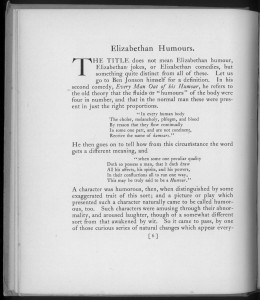
The introduction to Elizabethan Humours and the Comedy of Ben Jonson begins:
“The Stanford English Club issues this little book in connection with, and in commemoration of, the presentation of Jonson’s Every Man in his Humour at Stanford University in March, 1905.
“This is one of a series of presentations of old English plays in the Elizabethan manner, the first of which was the revival of Beaumont and Fletcher’s Knight of the Burning Pestle, in March, 1903. The enthusiastic reception accorded this effort encouraged the English Club to preserve the Elizabethan stage built for the play, so that it might be permanently available for such presentations, and to invite Mr. Ben Greet and his company of English players to come to Stanford in the fall semesters of both 1903 and 1904. the Greet company produced, beside the old Morality play of Everyman, two Shaksperean [sic] comedies, Twelfth Night and Much Ado About Nothing, and last of all, Hamlet–the second time in America that Shakspere’s greatest work has been produced in full and in the Elizabethan manner.”

The stage that the Stanford English Club built (see frontispiece at right) was modeled in part on the Swan Theatre as represented in a 1596 drawing reproduced in 1903’s Knight of the Burning Pestle. The stage extended directly to the “pit” where the “groundlings” (who had only paid for standing room) were gathered. The stage included a rear portion between two pillars, screened if necessary from downstage by a curtain called a “traverse,” and a upper balcony on the second floor.
After the introduction, the book contains several essays on Jonson and the Elizabethan era:
- Elizabethan Humours, by Raymond Macdonald Alden (author of the Elder publication Consolatio)
- Jonson’s Learned Sock, by Melville B. Anderson (1851-1933. Professor of English at Stanford University)
- Upon Ben Jonson, a poem by Edmund Waller
- Ben Jonson’s Prologue to Every Man in His Humour
- Epilogue, written for the 1675 revival of Every Man in His Humour by Charles Sackville, Earl of Dorset
- Dickens and His Friends, from The Life of Charles Dickens, vol. 2, chap. 9, by John Forster, 1845 (Charles Dickens played the part of Captain Bobadil [see plate below] during an 1845 revival)
- reproductions of portraits of Jonson, Shakespeare, Richard Burbage, David Garrick, and Dickens
- A Satire on a “Paul’s Man”, from Virgidemiarum, Book III, Satire 7, by Joseph Hall, 1597
- A Satire on Humours, from The Scourge of Villainy, Satire XI, by John Marston, 1598
- Ode to Jonson, by Robert Herrick

Ben Jonson wrote Every Man in His Humour in 1598 as a “humours comedy,” in which each major character is dominated by an overriding humour or obsession. The play was probably performed for the first time by the Lord Chamberlain’s Men in 1598 at the Curtain Theatre. Based on the playlist published in the 1616 folio of Jonson’s works, the part of Kno’well, the aged father, was almost certainly performed by William Shakespeare himself, who evidently enjoyed playing older characters.
